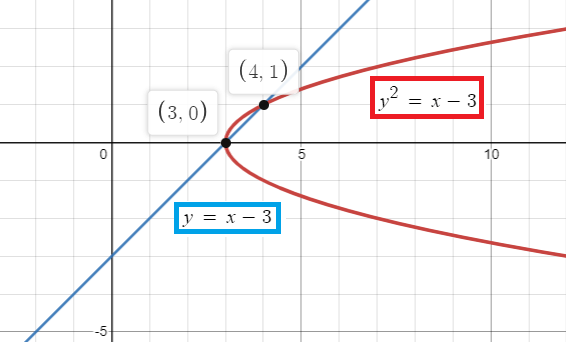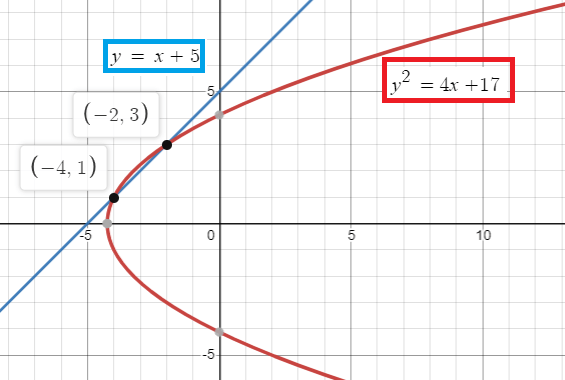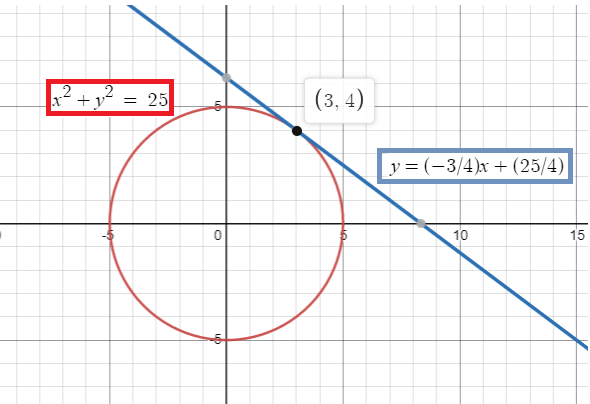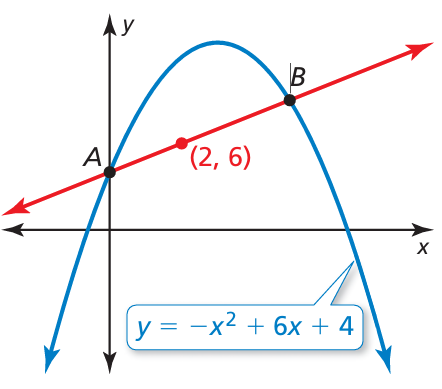SOLVING NONLINEAR SYSTEMS OF EQUATIONS
The degrees of the given systems will be different. Means one equation may be quadratic, cubic or polynomial.
To solve this system of equation, we may use substitution.
- Consider the equations as (1) and (2).
- From any one of the equations, we can derive the value of one variable in terms of other variable.
- Apply the value of one variable into other equation and solve it.
- To check the answer, we may use graph.
Solve the nonlinear system. Justify your answer with a graph.
Problem 1 :
y2 = x − 3 and y = x - 3
Solution :
y2 = x − 3 -------(1)
and
y = x - 3 -------(2)
Apply (2) in (1)
(x - 3)2 = x - 3
x2 - 2x(3) + 32 = x - 3
x2 - 6x + 9 = x - 3
x2 - 6x -x + 9 + 3 = 0
x2 - 7x+ 12 = 0
(x - 4) (x - 3) = 0
Equating each factor to 0, we get
x = 4 and x = 3
|
When x = 4 y = 4 - 3 y = 1 |
When x = 3 y = 3 - 3 y = 0 |
So, the point of intersections are (4, 1) and (3, 0).
Check with graph :

Problem 2 :
y2 = 4x + 17 and y = x + 5
Solution :
y2 = 4x + 17 -----(1)
and
y = x + 5 -----(2)
Applying (2) in (1), we get
(x + 5)2 = 4x + 17
x2 + 2x(5) + 52 = 4x + 17
x2 + 10x +25 = 4x + 17
x2 + 10x - 4x +25 - 17 = 0
x2 + 6x + 8 = 0
(x + 2)(x + 4) = 0
Equating each factor to zero, we get
x = -2 and x = -4
|
When x = -2 y = -2 + 5 y = 3 |
When x = -4 y = -4 + 5 y = 1 |
So, the point of intersections are (-2, 3) and (-4, 1)
Check with graph :

Problem 3 :
x2 + y2 = 4
y = x - 2
Solution :
x2 + y2 = 4 -------(1)
y = x - 2 -------(2)
Applying (2) in (1), we get
x2 + (x - 2)2 = 4
x2 + x2 - 2x(2) + 22 = 4
2x2 - 4x + 4 = 4
Subtracting 4 on both sides, we get
2x2 - 4x = 0
2x(x - 2) = 0
2x = 0 and x - 2 = 0
x = 0 and x = 2
When x = 0, then y = 0 - 2 ==> -2
When x = 2, then y = 2 - 2 ==> 0
So, the points of intersections are (0, -2) and (2, 0).
Problem 4 :
x2 + y2 = 25
y = (-3/4)x + (25/4)
Solution :
x2 + y2 = 25 ----(1)
y = (-3/4)x + (25/4) -----(2)
Applying (2) in (1), we get
(x - 3) (x - 3) = 0
x = 3 and x = 3
When x = 3, then y = (-3/4)(3) + (25/4)
y = -9/4 + 25/4
y= 16/4
y = 4

Problem 5 :
Use the graphs of the linear and quadratic functions.

a. Find the coordinates of point A.
b. Find the coordinates of point B.
Solution :
a) By observing thea graph given above, Point A will be (0, y)
y = -x2 + 6x + 4
y = -02 + 6(0) + 4
y = 4
So, the required point A will be (0, 4).
b) Two point on the line are (0, 4) and (2, 6)
Slope = (6 - 4) / (2 - 0)
= 2/2
= 1
Equation of the line :
y - y1 = m(x - x1)
(y - 4) = 1(x - 0)
y = x + 4
Solving the system of equations, we get
y = x + 4 ------(1)
y = -x2 + 6x + 4 ------(2)
(1) = (2)
x + 4 = -x2 + 6x + 4
x2 + x - 6x = 0
x2 - 5x = 0
x(x - 5) = 0
x = 0 and x = 5
Applying the value of x, we get
|
When x = 0 y = -02 + 6(0) + 4 y = 4 |
When x = 5 y = -52 + 6(5) + 4 y = -25 + 30 + 4 y = -25 + 34 y = 9 |
So, the required points are (0, 4) and (5, 9). Point B is (5, 9).
Recent Articles
-
Finding Range of Values Inequality Problems
May 21, 24 08:51 PM
Finding Range of Values Inequality Problems -
Solving Two Step Inequality Word Problems
May 21, 24 08:51 AM
Solving Two Step Inequality Word Problems -
Exponential Function Context and Data Modeling
May 20, 24 10:45 PM
Exponential Function Context and Data Modeling